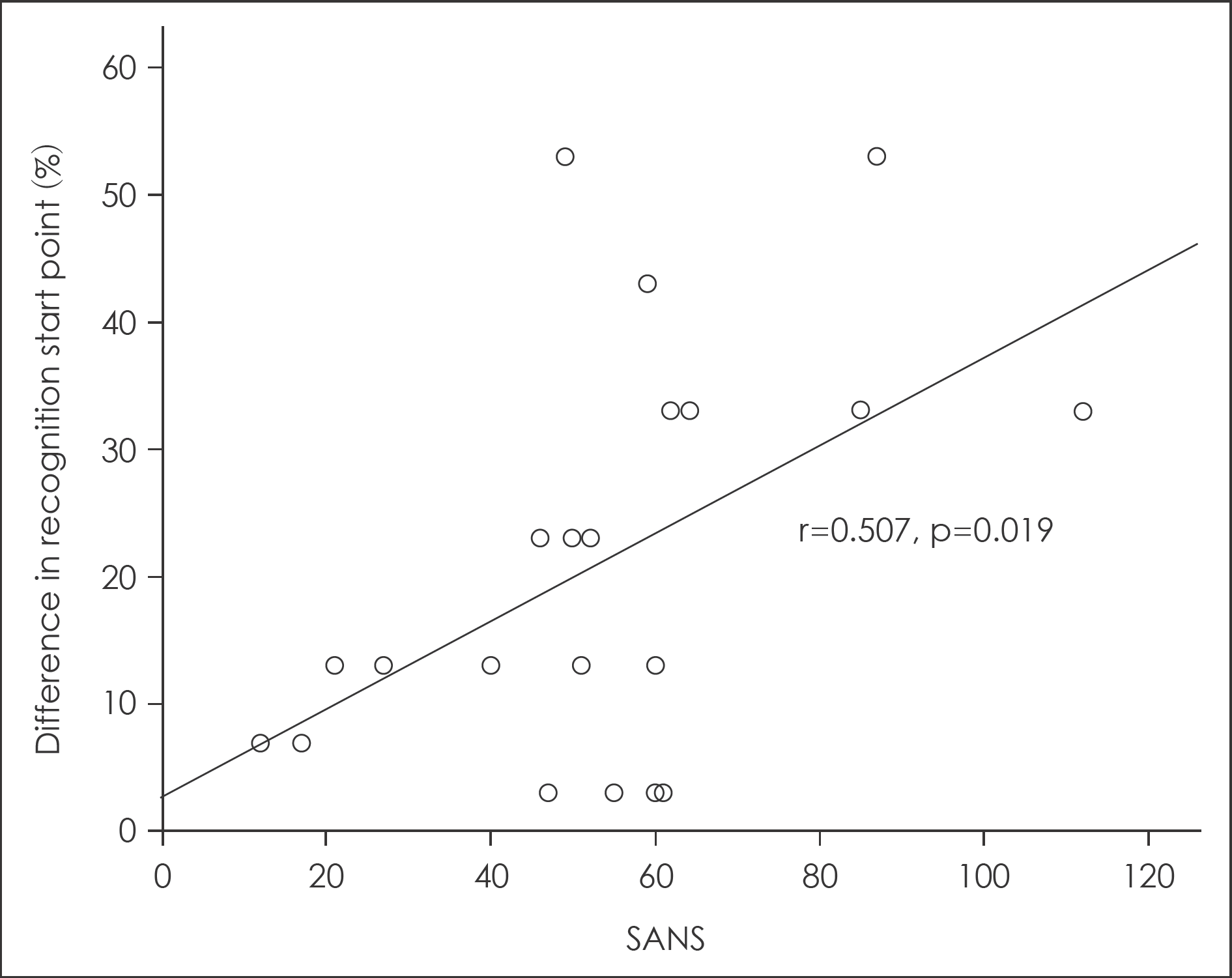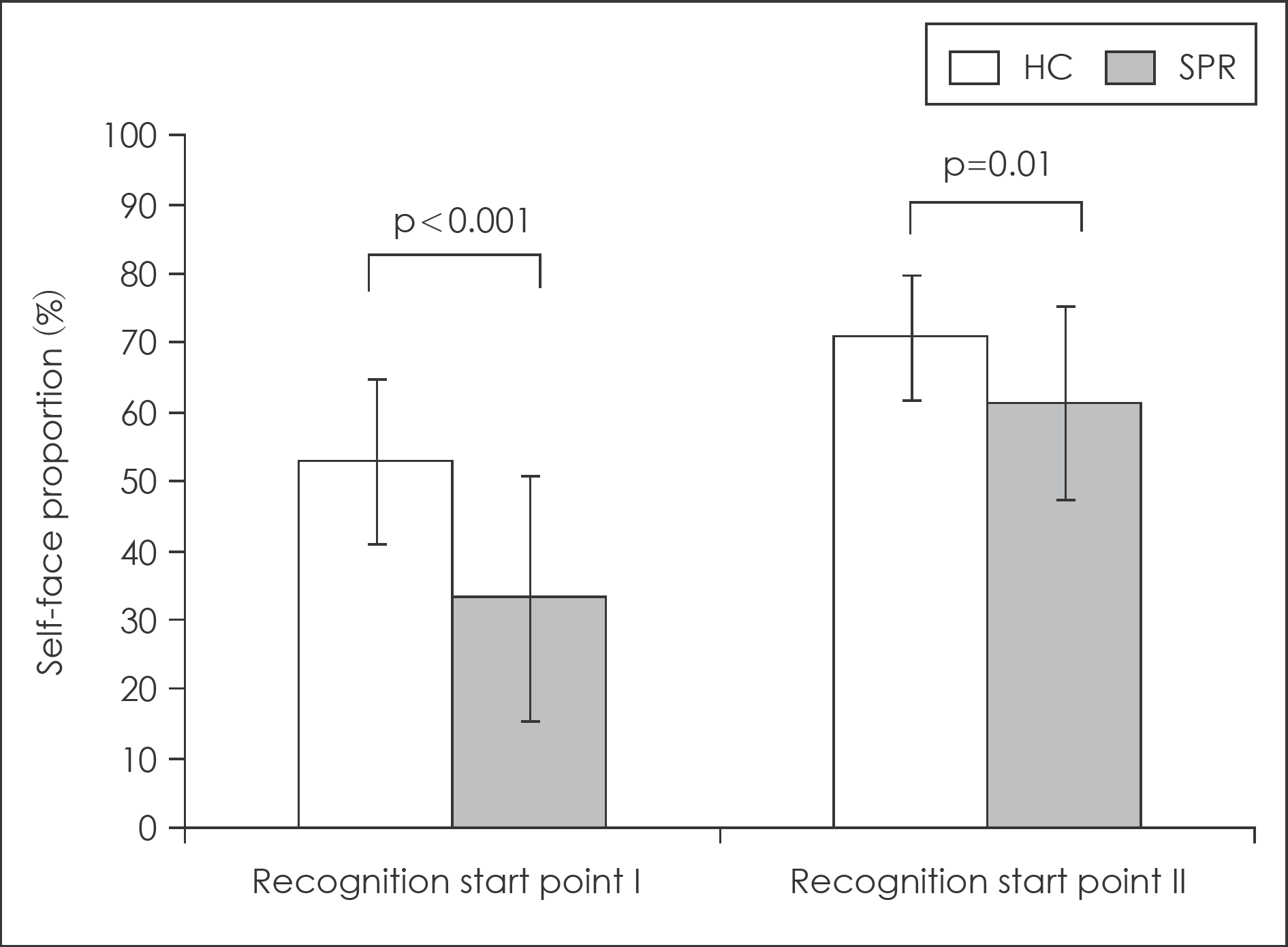Abstract
Objectives
Disturbance in self-experience has been considered to be a core feature of schizophrenia. Evidence from mirror face-recognition tasks supports the connection between self-face recognition and self-awareness which is a part of self-experience. The aim of this study was to investigate the self-other boundary recognition using morphed face pictures in patients with schizophrenia.
Methods
Twenty-one patients with schizophrenia and twenty-three healthy controls completed the self-face recognition task that consisted of various morphed pictures. Participant's own picture was morphed with each of three different, unknown, gender-matched facial identities in steps of 10%; each pair producing 11 images with graded blending of facial features. Thirty-three images in total were randomly presented as stimuli in a run, which was repeated three times. Participants were instructed to choose whether the stimulus was self-face or not.
Results
Self-face proportion was significantly lower in the schizophrenia group at both recognition start point I and II (33.33% vs. 53.04%, p<0.001; 61.43% vs. 70.87%, p=0.01, respectively). Using the mean value of each recognition start point in the control group, we calculated the difference in self-face proportion for each individual with schizophrenia. There was a significant correlation between the degree of this difference and total Scale for the Assessment of Negative Symptoms (SANS) score at recognition start point I (r=0.507, p=0.019).
Go to : 
REFERENCES
1). Bleuler E. Dementia Praecox, or the Group of Schizophrenias (Translated by J. Zinkin) International Universities Press. New York (original work published in 1911);1950.
2). Parnas J, Sass LA. Self, solipsism, and schizophrenic delusions. Philos Psychiatr Psychol. 2001; 8:101–120.

3). Schneider K. Clinical psychopathology.(Trans. by MW Hamilton). 1959.
4). Sass LA, Parnas J. Schizophrenia, consciousness, and the self. Schizophr Bull. 2003; 29:427–444.

5). Frith CD, Done DJ. Towards a neuropsychology of schizophrenia. Br J Psychiatry. 1988; 153:437–443.

6). McGuire PK, Silbersweig DA, Wright I, Murray RM, David AS, Frac-kowiak RS, et al. Abnormal monitoring of inner speech: a physiological basis for auditory hallucinations. Lancet. 1995; 346:596–600.

7). Allen PP, Johns LC, Fu CHY, Broome MR, Vythelingum GN, McGuire PK. Misattribution of external speech in patients with hallucinations and delusions. Schizophr Res. 2004; 69:277–287.

8). Waters F, Woodward T, Allen P, Aleman A, Sommer I. Self-recognition deficits in schizophrenia patients with auditory hallucinations: a metaanalysis of the literature. Schizophr Bull. 2012; 38:741–750.

9). Johns LC, Allen P, Valli I, Winton-Brown T, Broome M, Woolley J, et al. Impaired verbal self-monitoring in individuals at high risk of psychosis. Psychol Med. 2010; 40:1433–1442.

10). Daprati E, Franck N, Georgieff N, Proust J, Pacherie E, Dalery J, et al. Looking for the agent: an investigation into consciousness of action and self-consciousness in schizophrenic patients. Cognition. 1997; 65:71–86.

11). Thakkar KN, Nichols HS, McIntosh LG, Park S. Disturbances in body ownership in schizophrenia: evidence from the rubber hand illusion and case study of a spontaneous out-of-body experience. PLoS One. 2011; 6:e27089.

12). Kircher TT, Seiferth NY, Plewnia C, Baar S, Schwabe R. Self-face recognition in schizophrenia. Schizophr Res. 2007; 94:264–272.

13). Lee J, Kwon JS, Shin YW, Lee KJ, Park S. Visual self-recognition in patients with schizophrenia. Schizophr Res. 2007; 94:215–220.

14). Heinisch C, Wiens S, Grundl M, Juckel G, Brune M. Self-face recognition in schizophrenia is related to insight. Eur Arch Psychiatry Clin Neurosci. 2013; 263:655–662.

15). Zahavi D, Roepstorff A. Faces and ascriptions: mapping measures of the self. Conscious Cogn. 2011; 20:141–148.

16). Preyer WT. The Mind of the Child: The development of the intellect: Appleton. 1889.
18). Sugiura M, Sassa Y, Jeong H, Wakusawa K, Horie K, Sato S, et al. Self-face recognition in social context. Hum Brain Mapp. 2012; 33:1364–1374.

19). Lee J, Nam S, Lee M, Lee J, Lee S. Rosenberg self-esteem scale: analysis of item-level validity. The Korean Journal of Counseling and Psychotherapy. 2009; 21:173–189.
20). Kim JH, Ahn CY. Effect of self-focused attention on anxiety. Kor J Psychol: Clin. 1991; 10:243–261.
21). Lee YJ, Seok JH, Jeon JH, An SK, Kim JJ, Lee HS. Development of Korean Version of Schizotypal Ambivalence Scale (K-SAS). J Korean Neuropsychiatr Assoc. 2005; 44:58–64.
22). Yi JS, Ahn YM, Shin HK, An SK, Joo YH, Kim SH, et al. Reliability and Validity of the Korean Version of the Positive and Negative Syndrome Scale. J Korean Neuropsychiatr Assoc. 2001; 40:1090–1105.
23). Andreasen NC, Arndt S, Miller D, Flaum M, Nopoulos P. Correlational studies of the Scale for the Assessment of Negative Symptoms and the Scale for the Assessment of Positive Symptoms: an overview and update. Psychopathology. 1995; 28:7–17.

24). Kirkpatrick B, Fenton WS, Carpenter WT Jr, Marder SR. The NIMH-MATRICS consensus statement on negative symptoms. Schizophr Bull. 2006; 32:214–219.

25). Welham J, Stedman T, Clair A. Choosing negative symptom instruments: issues of representation and redundancy. Psychiatry Res. 1999; 87:47–56.

26). Park JY, Oh JM, Kim SY, Lee MK, Lee CR, Kim BR, et al. Korean Facial Expressions of Emotion. KOFEE. Section of Affect & Neuroscience, Institute of Behavioral Science in Medicine, Yonsei University College of Medicine, Seoul, South Korea. 2011.
Go to : 
 | Fig. 2.Scatter plot between Difference in Recognition Start Point I and SANS score in Schizophrenia group. r : Pearson's correlation efficient |
Table 1.
Clinical characteristics of the subjects
| Characteristic | Healthy control (n=23) | Schizophrenia (n=21) | p-value |
|---|---|---|---|
| Gender (male : female) | 11 : 12 | 12 : 9 | 0.537 |
| Age (years) | 40.13±9.61 | 40.95±9.88 | 0.781 |
| Education (years) | 14.87±2.93 | 12.10±2.23 | 0.001∗ |
| Schizotypal Ambivalence Scale (SAS) | 5.43±3.74 | 10.05±5.55 | 0.003∗ |
| Rosenburg Self-Esteem Scale (RSES) | 30.30±4.55 | 25.86±6.86 | 0.014∗ |
| Self-Consciousness Scale (SCS) | 38.91±11.15 | 46.81±10.84 | 0.022∗ |
| Private self-consciousness subscale | 19.35±5.01 | 20.86±4.69 | 0.309 |
| Public self-consciousness subscale | 12.39±4.30 | 14.90±5.23 | 0.088 |
| Social anxiety subscale | 7.17±4.20 | 11.05±5.58 | 0.012∗ |
| PANSS | - | 85.71±27.81 | |
| Positive scale | - | 20.81±8.12 | |
| Negative scale | - | 23.33±6.56 | |
| General psychopathology scale | - | 41.57±15.98 | |
| SANS | - | 53.19±23.48 |
Table 2.
Reaction time and omission rate
| Characteristic | Healthy control (n=23) | Schizophrenia (n=21) | p-value |
|---|---|---|---|
| Total mean reaction time (ms) | 1005.84±219.38 | 1639.12±1205.47 | 0.027∗ |
| At recognition start point I | 1183.55±347.12 | 1598.26±823.28 | 0.042∗ |
| At recognition start point II | 1253.94±466.73 | 2114.84±2348.88 | 0.113 |
| Omission rate (%) | 0.35±0.58 | 1.20±1.55 | 0.026 |




 PDF
PDF ePub
ePub Citation
Citation Print
Print



 XML Download
XML Download